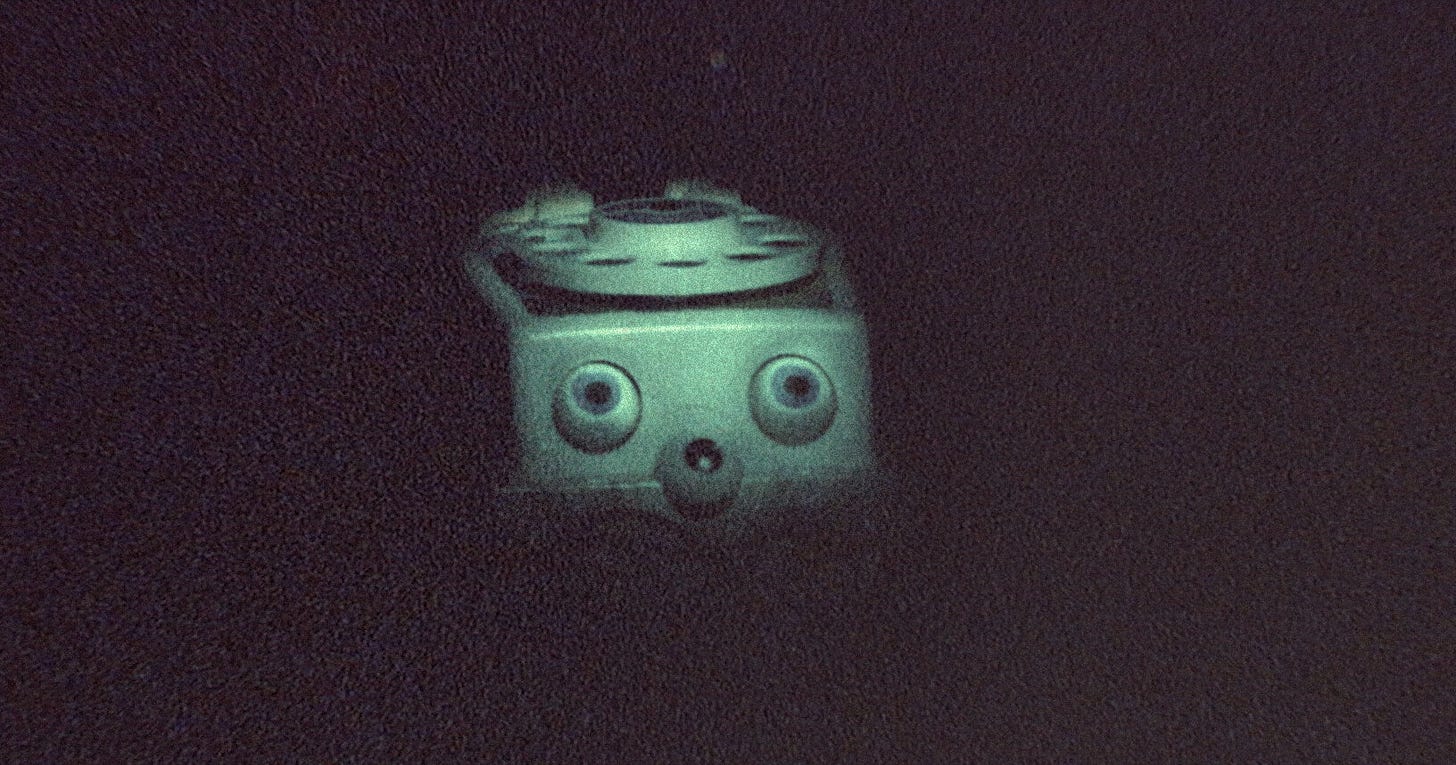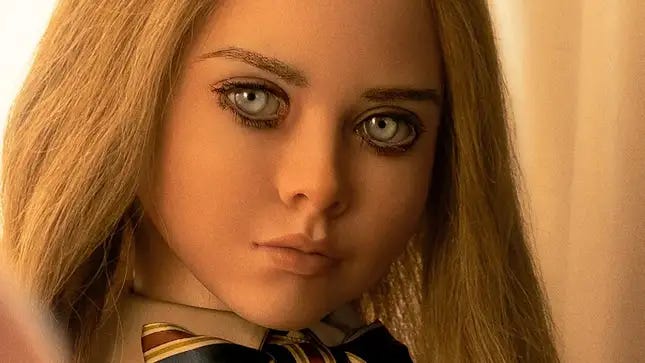Horrorscope
One of the most fluid genres in film, horror can be a bellweather of both the industry and our subconscious.
Now that the industry award season is over and one of the most successful genre films in modern cinematic history ran the table (congrats to Everything Everywhere All at Once, btw) I wanted to take a look at the real stars of the early year release schedule: horror films.
Often considered a dumping ground for substandard fair, or a dumping ground for the previous year’s holdovers, the period from January to March typically sees a wealth of horror programming. We reviewed January’s breakthrough hit M3GAN on this week’s pod, which got me thinking about the trends in the genre. Where is the form headed and who is taking us there?
For answers, I recruited my friend and former classmate Laura Moss. Laura is an award winning director and horror scholar (my words) whose first feature birth/rebirth is set for theatrical distribution this August by Shudder. Their short film Fry Day is available on the Criterion Channel and their next feature screenplay Gordon is a real banger (at least the last time I read it.)
I cannot go too deeply into the details of birth/rebirth and here’s why: the first time Laura told me about the idea behind the film many years ago, I passed out and slammed my face into the bar of a pub on the Lower East Side, breaking my two front teeth. So color me unsurprised at the reports from Sundance of several men suffering the same fate. We are delicate, the lot of us.
A.J. Lister in birth/rebirth
I’ve asked Laura for feedback on the following trends to ensure I’m not completely full of shit. It’s a tough task to be sure!
To start, when asked about the shape of horror as a genre, they said, “I think about it like if you are conducting an orchestra. It’s the same piece of music from different conductors, but some instrument is brought out by one and not the others.”
Here are the instruments I’m hearing the most lately:
Eternal Nostalgia
Last year saw the reboot of the Hellraiser franchise, a new entry into the Predator series with Prey, and the end of David Gordon Greene’s Halloween run with, um… Halloween Ends. Even new entries into the genre like Ti West’s X and Pearl hearken back to a 70’s ad 80’s aesthetic. Nostalgia is an ever-present force in cinema, but especially so in horror.
“Isn’t that like an evergreen problem?” Laura sums up nicely. Horror is one of the most exploited genres on the back of its past successes, and there are certainly reasons why.
First, popular horror films rely on identifiable intellectual property, though that is hardly unique. But second and crucially, they are (comparatively) cheap. So even at the high end, you spend $33 million to slap a Mike Myers mask on a guy and have him amble around for an hour and a half and you easily guarantee a $100+ million.
In 2023, the trend marches on with remakes, prequels, and sequels Evil Dead Rises, Scream 6, The First Omen, Salem’s Lot, and proving that the Devil is indeed among us, a new Exorcist film.
Creepypasta Eats
When a nearly unwatchable film made for $15,000 crosses the $2 million mark at the box office, we have to start asking some questions. The first of which may be “What the fuck is a Skinamarink,” and that would be fair. In what amounts to more of a challenge than a film, the genesis of this movie was from the dark recesses of YouTube, where creators have been messing around for years trying to be, well, creepy.
Laura is excited about the potential of this new space, though with caveats. “Experimental horror! Which is fucking cool…. I’m glad I saw it in a theater because I’m not sure I would have gotten through it at home.”
Unsettling images, sounds, and scenarios prevail over jump scares and gore. And low budgets are de facto in a way that recalls the earliest found footage films from the late nineties and early aughts. The form has caught on with some critics already, as 2021’s We’re All Going to the World’s Fair rates a 92% with critics on Rotten Tomatoes.
Personally, this sub-genre hasn’t hit for me yet. I prefer my movies to look like actual movies, but we may only be a year or two away from the creepypasta version of Blair Witch.
Laura gives me a bit of hope: “I like that these things are happening…. What I like about [Shudder] is I feel like they are saying ‘OK, horror is it’s own universe and all these things belong in it.’”
The Artists
Some of my favorite horror films are made by incredibly talented directors that are not specifically “horror” directors. Polanski (a genuinely horrific person) made Rosemary’s Baby just before Macbeth and followed that three years later with Chinatown. The Exorcist was William Friedkin’s follow-up to the gritty police story The French Connection. And even horror legends like John Carpenter went down the occasional action/comedy path with Big Trouble in Little China.
So too is our new generation of horror auteurs. Led by Oscar winner Jordan Peele (along with productions from his company Monkeypaw,) these are the kinds of films that are referred to, often with a sharp tongue, as “elevated horror.” While this is nothing new, directors like Peele, Ari Aster (Hereditary, Midsommer,) and Robert Eggers with his upcoming take on Nosferatu choose to use horror as an entry point to larger thematic questions. They are not necessarily in it for primal fear, but what those fears can stand for.
When asked about whether horror movies in search of a message can be truly hit, Laura provides historical perspective. “For me great horror should be subversive, but this is not always the case. The famous example is you take The Exorcist and Rosemary’s Baby, both films about the Devil, and one of them is incredibly subversive and one of them re-enforces the status quo. They are both horror movies, and both effective horror movies, but are carrying with them different messages.”
2022’s Nope is a great example of this. The film is more thriller and mystery than it is horror, and its exploration of spectacle is more primary to the film’s message than any of its horror tropes.
Peele’s history in sketch comedy and Aster’s next film Beau is Afraid, which seems to at least border on comedy, are perhaps instructive in helping us understand this paradigm.
Joaquin Phoenix in Beau Is Afraid
As comedy and horror both disarm us and snap us away from expectation and preconceived notions, they also allow for metaphor that will always attract a certain type of storyteller.
Where-scares?
The final category is represented in our most recent podcast with the film M3GAN. These are “horror” movies that are not scary. No jump scares, no social commentary presented through buckets of red corn syrup, not even a single fucking demon child.
While I enjoyed M3GAN for what it was (and to a degree Malignant as well) they are basically action/comedy films with enough murder to make for a scary poster.
And as these types of films have grown in popularity thanks to the success of Blumhouse and Atomic Monster and the meme-ability of their central premise, I expect to see a lot more of these fun, vapid, and ultimately FINE movies.
But I may be being too harsh, and Laura made sure to point out the value of these types of film in the world of horror as they are additive to its diversity. “It is a cool, exciting moment…. The fact that we’re rattling off Malignant, M3GAN, Barbarian, Smile… there’s just a lot of breadth in horror now, which is really cool. It’s an alternative to an IP driven universe.”
The Rest, In Peace
There are plenty of other trends in horror to explore, and like an iceberg of frozen carrion, 90% of it is under the surface. Horror has a vibrant and disgusting underground of VOD releases and first-time filmmakers trying new things. There’s no way I could categorize it all, but places like Sundance’s Midnight section and the streaming service Shudder are great places to start.
Thanks to my friend Laura Moss for their insight on the genre, I look forward to losing consciousness while watching their film.
f.








